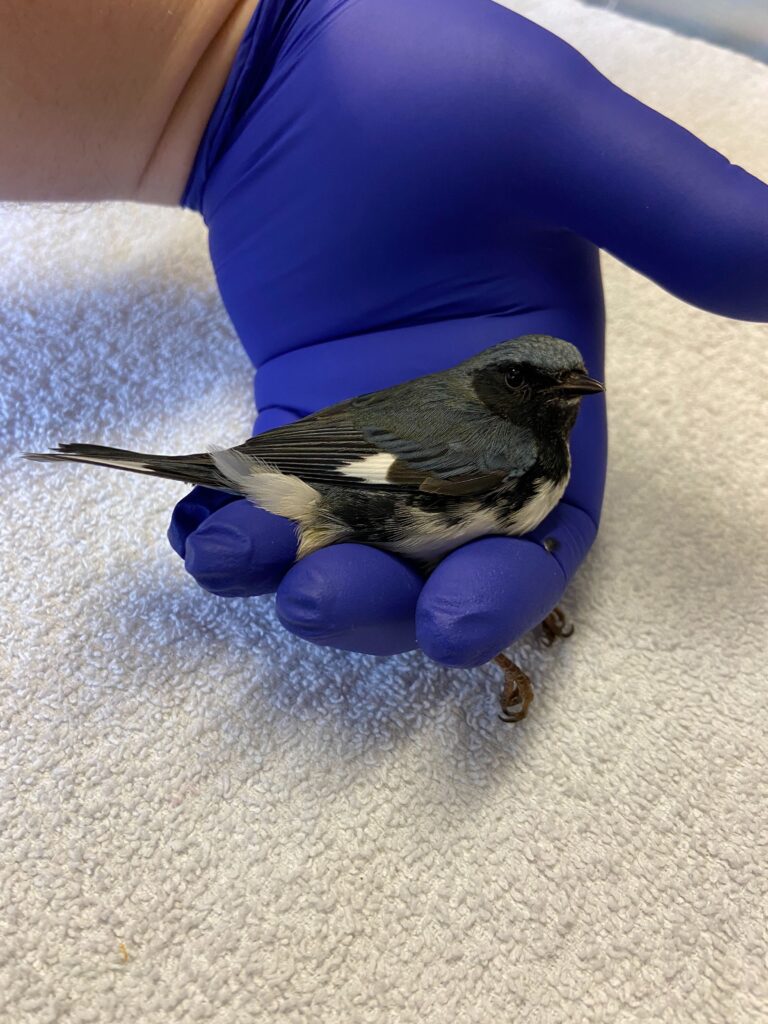
A common yellowthroat, one of the many species of migrating birds passing over the city. This one collided with a plate glass window, but happily was only dazed, brought to the Wildlife Clinic, treated, and released– a conservation success story.
It’s migration season and millions of birds are right now pouring over the city of Philadelphia on their way to northern nesting grounds. A river of warblers, flycatchers, shorebirds, hummingbirds, thrushes, and more are heading to their ancestral mating grounds.
And Bird Safe Philly, a new partnership, hopes to make their travels safer. Birds colliding with plate-glass windows in cities is, sadly, a longstanding issue that the group hopes to address– and mitigate. Two leaders of the Bird Safe Philly effort will be on hand at the Schuylkill Centers’s Earth Day Live event on Thursday, April 21 at 7:00 p.m., a free celebration of the Earth Day holiday.
Leigh Altadonna, president of Wyncote Audubon Society and one of the founders of Bird Safe Philly, joins Chris Strub, the director of the Wildlife Clinic at the Schuylkill Center, at the event.
The partnership partly grew out of a horrific event on October 2, 2020, when, during the birds’ migration south, poor-visibility weather colluded with confusing big-city lights to cause the death of 1,500 migratory birds in a single night in Philadelphia, resulting in a lot of media attention in Philly and nationwide. Turns out bright lights can confuse birds, who migrate at night, especially when clouds don’t allow them to navigate via stars.
“I reached out and convened a meeting of key bird people,” Leigh told me last week, “like Audubon Mid-Atlantic, Audubon’s Wyncote and Valley Forge chapters, the Delaware Valley Ornithological Club, probably the oldest bird club in Philly, and the Academy of Natural Sciences. We talked about the need to get on a light’s-out movement in the city.” Leigh was “anointed,” as he said, the coordinator of Bird Safe Philly, convening meetings and working groups, and a partnership was forged.
Lights Out Philly is one of the project’s big successes. Multiple brightly lit skyscrapers– the Cira Centre, the FMC Tower, Liberty Place, many owned by Brandywine Realty Trust– join other well-known buildings like the Convention Center and the Wells Fargo Center in agreeing to turn off their lights during migration season from midnight to 6 a.m. Maybe you’ve noticed this on late-night drives through the city.
While PECO, a corporate sponsor of the program, hasn’t turned off its iconic crown lights, it has dimmed their intensity and shifted the wavelength. “They’ve agreed to change the light colors,” Leigh told me, “as blue and green are a little better than the other colors. Another big thing PECO did was volunteer to place info about us in their billing; they did a great insert– that was helpful too.”
He continued, “But well over 50% of these birds die from collisions with low-story buildings of four stories or less.” So it’s great that smaller buildings like the American Philosophical Society and Ursinus College have signed on. As a longtime administrator for the Abington School District, he said, “I’d love to see the Philadelphia School District adopt this program, and their buildings turn off their second, third and fourth floors light. They probably comply already in most cases.”
“What is really great,” he offered, “is we have volunteer monitors that go down early in the morning starting at five. They go around and look for bird casualties– ‘bag and tag’ them so to speak. These all go to the Academy of Natural Sciences, and become part of the research effort to get data on size and scope of the issue.”
Since not all of the birds are dead, happily some of them are only dazed, or perhaps suffering from concussions. “We have a cadre of volunteers who transport injured birds to the Wildlife Clinic.” That’s where Chris Strub comes in.
“Chris and his staff have been great,” Leigh offered. “These stunned birds, sitting on the ground, are easy prey for cats, rats, and more. Without intervention, they would likely die. But with the help from the clinic staff, the success rate in healing them has been close to 80%. That’s pretty significant– we really credit the clinic for helping with this.”
About 200 birds come to our clinic annually through the transport program. Chris Strub notes, “It’s really rewarding to actually make a difference in the window-strike story. We don’t have the capacity to go out and get the birds, but we do have the resources to treat them. Now that we are actually getting the birds, we can be part of the initiative, which eliminates a real source of frustration of not being able to go out and get them.
“I have immense respect for all the volunteers and organizers,” Chris continued, “who are walking the streets of Philadelphia in early mornings to find them while also witnessing the number of dead birds. This really inspires me, and brings home that bird conservation is a huge team effort– no one person can do it. It takes partnerships like this to ensure that a lot more of the birds survive and get a chance to further their species.”
Earth Day Live features both Chris and Leigh. In addition, historian Adam Rose, author of “The Genius of Earth Day,” recounts the importance of Earth Day in galvanizing environmental action, and the Center’s land stewardship coordinator Sam Bucciarelli highlights edible native plants you can grow in your garden. The free event is set for Thursday, April 21 at 7:00 p.m. via Zoom; register here.
By: Mike Weilbacher, Executive Director

